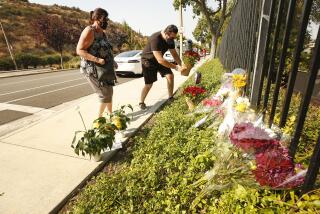Court Reinstates Motorist’s Suit Against GM in Hurled-Rock Case
- Share via
Reviving a lawsuit, a state appellate court has ruled that a motorist severely injured when a chunk of concrete smashed through the sunroof of a 1984 Corvette should have the chance to prove that General Motors designed the roof poorly.
Kurt Meyering, whose skull was shattered by the 6-pound chunk of concrete, should be able to take his $10-million suit to trial, even though he was hurt because two boys threw the concrete off a freeway overpass, the 4th District Court of Appeal ruled Friday.
Auto makers know that concrete and rocks sometimes fall off overpasses, so it should be just as foreseeable to designers that damage could be caused from an object that was thrown maliciously, the court said. No matter what the reason for the falling concrete, Meyering should have the chance to prove that the sunroof should have been stronger, the court said.
The court’s opinion was the most recent ruling in a series of cases Meyering has pursued since the Feb. 29, 1988 accident. He has sued GM, the dealer who sold him the car, the state of California, the two boys and the construction company that managed the site where the boys picked up the concrete.
Some of those cases already have been successful, resulting recently in a $2.4-million settlement with the state and a $3.8-million civil judgment against the two boys, said Meyering’s San Diego lawyer, David Rosenberg. The case against the construction company ended in October with a verdict in the company’s favor, however.
Meyering, 26, who now lives with his parents in Wenatchee, Wash., is pursuing the case against GM--which also includes the dealer, Ball Oldsmobile in National City--not only because he has yet to see any of the millions but because he cares deeply about auto safety, Rosenberg said. He called the 4th District court’s opinion a “tremendous victory.”
“We believe the court agrees with (Meyering) in the sense that car manufacturers must take into account risks that are inherent in today’s society and make appropriate design changes to protect the public,” Rosenberg said. “This case is about that very issue.”
Meyering’s brother, Ralph, an actor and screenwriter who lives north of Los Angeles, said Monday that the accident has left Kurt Meyering with the intellectual ability of a 12-year-old--and very angry. The court’s decision was “great news,” Ralph Meyering said.
Attorneys for GM could not be reached Monday for comment. Ed Chapin, a lawyer for Ball Oldsmobile, said this was a “result we would prefer not have had.”
“This appears to be an example of someone taking a theory and going to some lengths, taking it to an abusrb length, an absurd end,” Chapin said.
Now unemployed, Kurt Meyering was 24, a fashion model and an aspiring actor living in San Carlos on Feb. 29, 1988. He and his former girlfriend, Jane Casey, were heading north on Interstate 5 in her red Corvette--he driving, she in the passenger seat--when the concrete was hurled at the car from the Broadway overpass.
The chunk, which court records indicate was about the size of a cantaloupe and carried the force of an object traveling at 65 m.p.h., crashed through the plexiglass car roof and struck the top of Meyering’s head, shattering his skull. Casey was not hurt.
The 13-year-old boy who threw the concrete pleaded no contest to assault with a deadly weapon. He was ordered to spend a year in a “wilderness experience program,” an alternative to Juvenile Hall.
His companion, a 15-year-old boy who bet the younger boy $1 that he “didn’t have the guts” to throw the block, was found guilty on three counts of assault with a deadly weapon. He was sentenced to an indefinite term at a reformatory.
In the suit against GM and Ball Oldsmobile, Meyering claims that the plexiglass in the sunroof was too thin and too weak. A relatively inexpensive--and shatterproof--alternative would have prevented the injury, he claims.
On May 12, 1989, San Diego Superior Court Judge James R. Milliken dismissed the suit against GM. Two weeks later, San Diego Superior Court Judge Kevin Midlam dismissed the claims against Ball Oldsmobile.
In dismissing the suits, both judges ruled that the criminal conduct of the two boys was an unforeseeable event that neither the car maker nor the dealer could have guarded against.
But, in a 2-1 decision issued last Friday, the 4th District court reversed them.
In the majority opinion, Justice Howard B. Wiener said that GM need not anticipate a rock thrown from a freeway overpass. But, Wiener said, the auto maker could have foreseen the chance that an object could fall from above through the sunroof, since roadside signs frequently warn of falling rocks and objects sometimes tumble from trucks.
He affirmed the dismissal of the strict liability claim against the dealer, saying California law has long protected used-car sellers who had nothing to do with the initial defect.






